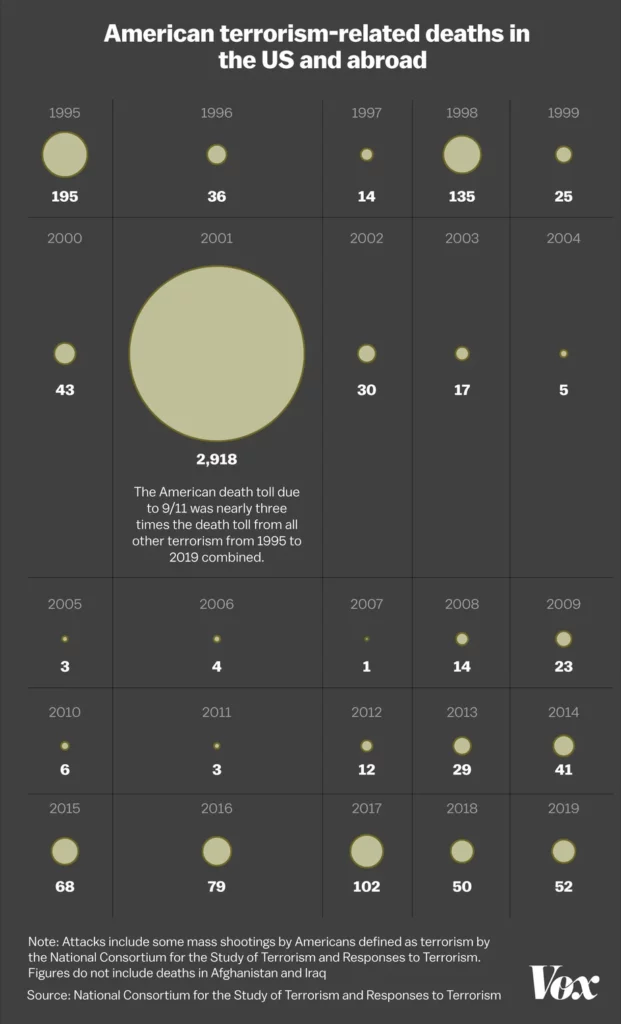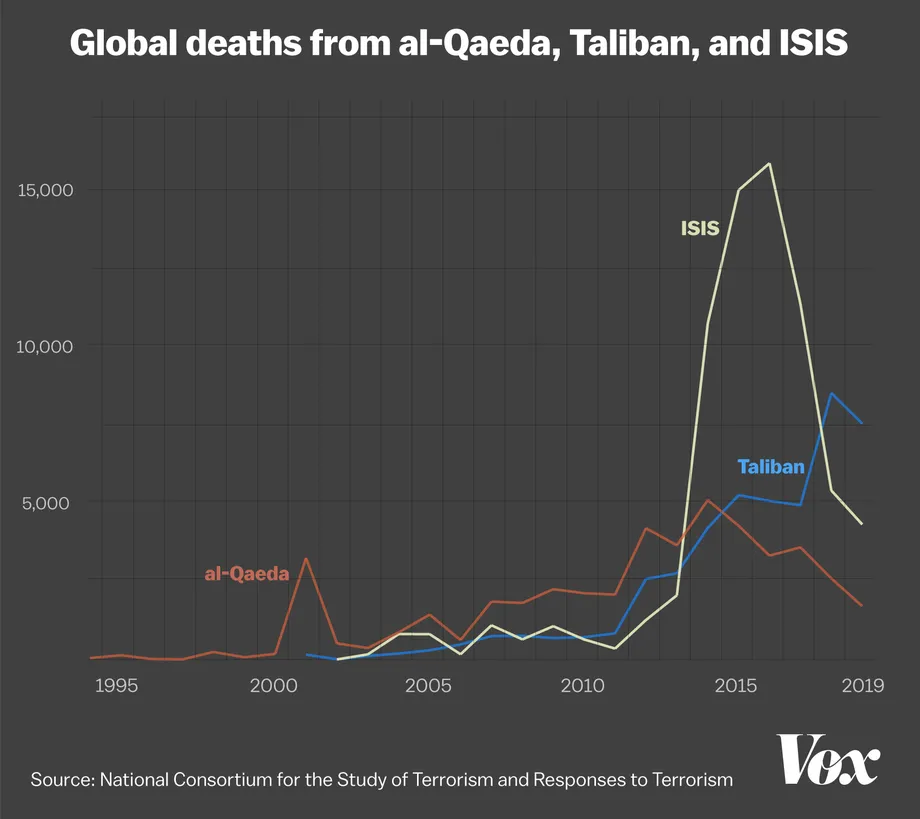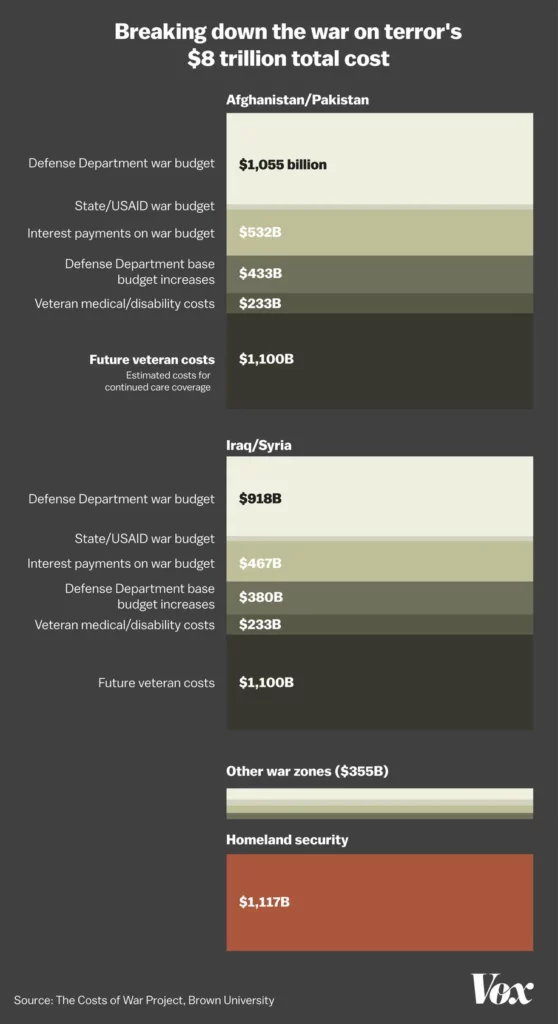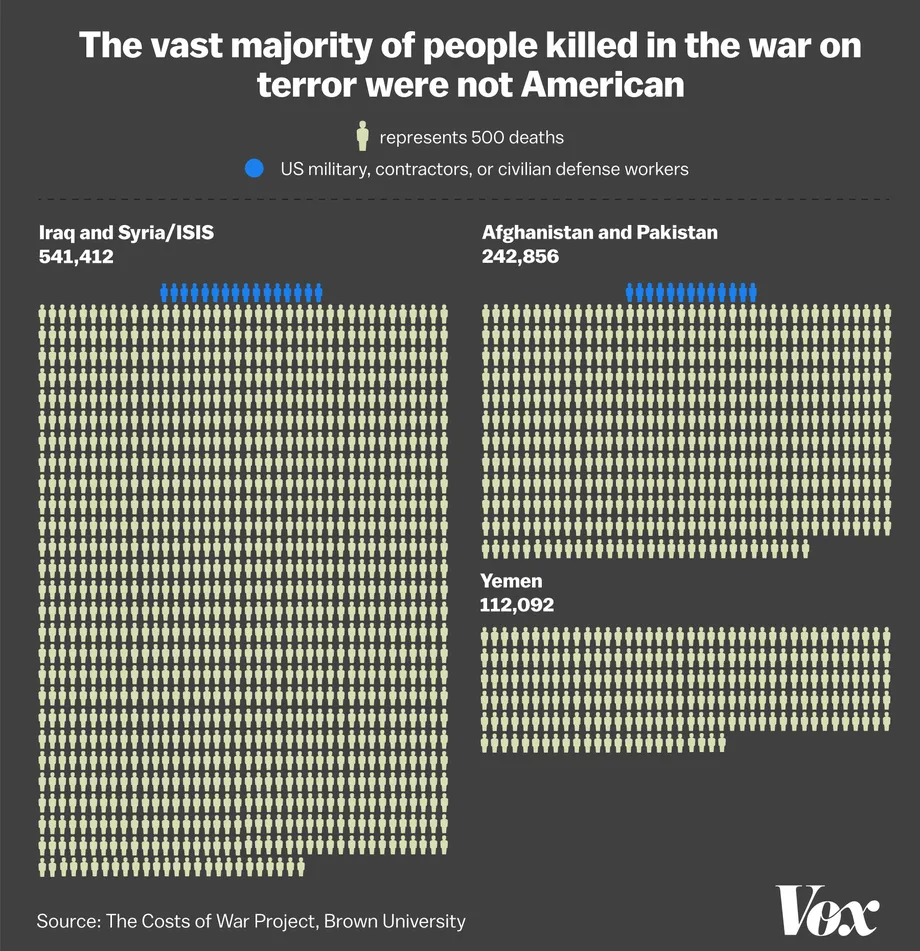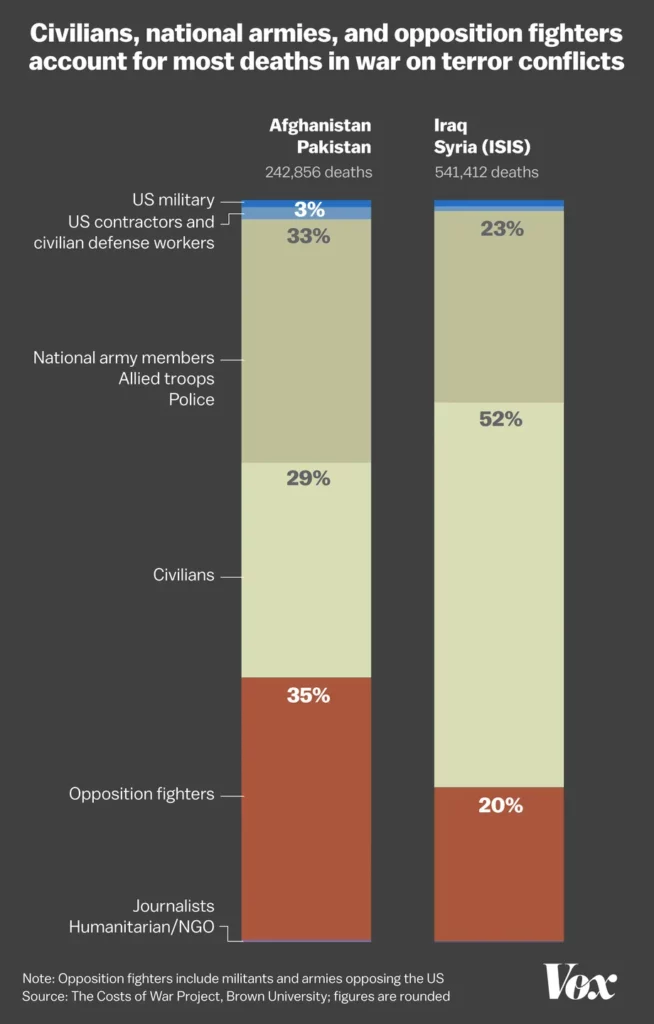20 Years, $6 Trillion, 900,000 Lives: The Enormous Costs and Elusive Benefits of the War on Terror
MILITARISM, 20 Sep 2021
Dylan Matthews | VOX - TRANSCEND Media Service
11 Sep 2021 – On the evening of September 11, 2001, hours after two hijacked airliners had destroyed the World Trade Center towers and a third had hit the Pentagon building, President George W. Bush announced that the country was embarking on a new kind of war.
“America and our friends and allies join with all those who want peace and security in the world, and we stand together to win the war against terrorism,”
Bush announced in a televised address to the nation.
It was Bush’s first use of the term that would come to define his presidency and deeply shape those of his three successors. The global war on terror, as the effort came to be known, was one of the most expansive and far-reaching policy initiatives in modern American history, and certainly the biggest of the 2000s.
It saw the US invade and depose the governments of two nations and engage in years- or decades-long occupations of each; the initiation of a new form of warfare via drones spanning thousands of miles of territory from Pakistan to Somalia to the Philippines; the formalization of a system of detention without charge and pervasive torture of accused militants; numerous smaller raids by special forces teams around the world; and major changes to air travel and border security in the US proper.
The “war on terror” is a purposely vague term. President Barack Obama famously rejected it in a 2013 speech — favoring instead “a series of persistent, targeted efforts to dismantle specific networks of violent extremists.”
But 9/11 signaled the beginning of a distinct policy regime from the one that preceded it, and a regime that exists in many forms to the present day, even with the US exit from Afghanistan.
Over the past 20 years, the costs of this new policy regime — costs in terms of lives lost, money spent, people and whole communities displaced, bodies tortured — have become clear. It behooves us, then, to try to answer a simple yet vast question: Was it worth it?
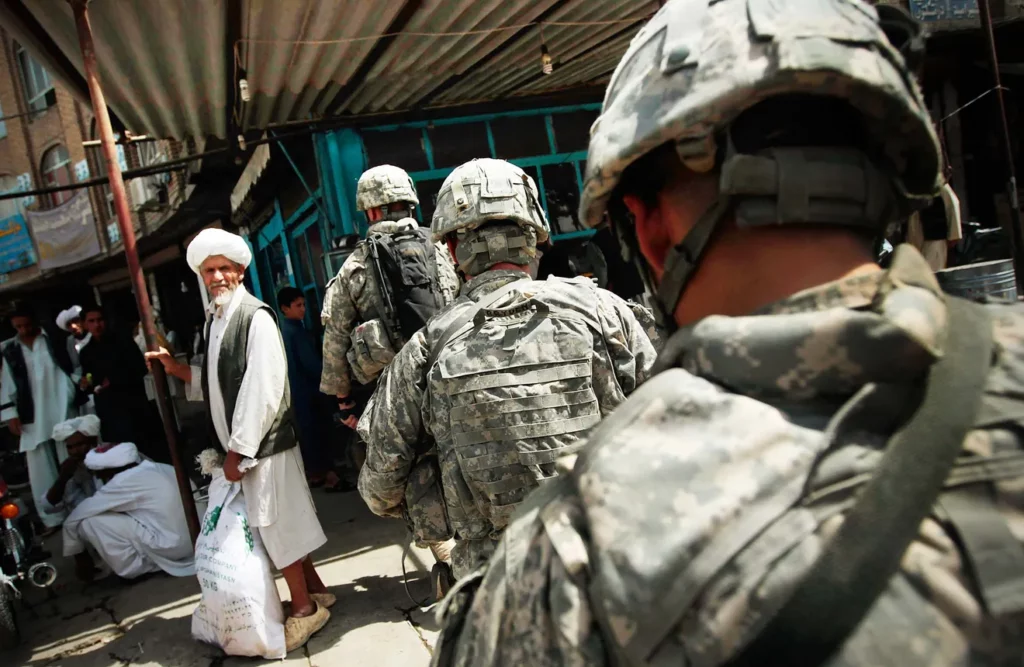
US Army paratroopers of the 82nd Airborne Division patrol the streets of downtown Herat, Afghanistan, on June 26, 2010. Chris Hondros/Getty Images
A good-faith effort to answer this question — to tally the costs and benefits on the ledger and not just resort to one’s ideological priors — is more challenging than you’d think. That’s largely because it involves quantifying the inherently unquantifiable. If, as proponents argue, the war on terror kept America safe, how do you quantify the psychological value of not being in a state of constant fear of the next attack? What about the damage of increased Islamophobia and violent targeting of Muslims (and those erroneously believed to be Muslims) stoked by the war on terror? There are dozens more unquantifiable purported costs and benefits like these.
But some things can be measured. There have been no 9/11-scale terrorist attacks in the United States in the past 20 years. Meanwhile, according to the most recent estimates from Brown University’s Costs of War Project, at least 897,000 people around the world have died in violence that can be classified as part of the war on terror; at least 38 million people have been displaced due to these wars; and the effort has cost the US at least $5.8 trillion, not including about $2 trillion more needed in health care and disability coverage for veterans in decades to come.
When you lay it all out on paper, an honest accounting of the war on terror yields a dismal conclusion: Even with an incredibly generous view of the war on terror’s benefits, the costs have vastly exceeded them. The past 20 years of war represent a colossal failure by the US government, one it has not begun to reckon with or atone for.
We are now used to the fact that the US government routinely bombs foreign countries with which it is not formally or even informally at war, in the name of killing terrorists. We are used to the fact that the National Security Agency works with companies like Facebook and Google to collect our private information en masse. We are used to the fact that 39 men are sitting in Guantanamo Bay, almost all detained indefinitely without trial.
These realities were not inevitable. They were chosen as part of a policy regime that has done vastly more harm than good.
What America and the world might have gained from the war on terror
Before going further, it’s important to define our terms. By “war on terror,” I mean all policy initiatives undertaken by the US government from September 11, 2001, to the present with a goal of fighting Islamist — and particularly al-Qaeda/ISIS — terrorism.
This means that not all US policy initiatives in the Middle East and North Africa are counted here as part of the war on terror. The stated rationale behind the NATO intervention in Libya in 2011, for instance, was to force a ceasefire in the country’s incipient civil war and to prevent Muammar Qaddafi’s army from committing atrocities against civilians — so it does not count for our purposes.
The US invasion and occupation of Iraq, by contrast, does count as part of the war on terror, for the simple reason that the Bush administration considered it so. The administration argued for and justified the invasion as a necessary measure to prevent terrorist groups from acquiring weapons of mass destruction and striking the United States.
The costs of the war in Iraq, and indeed of every other front in the war on terror, are relatively easy to relate: hundreds of thousands of lost lives, trillions in dollars spent, incalculable damage to the US’s reputation in the world.
So let’s start with a harder question: What, if any, benefits accrued to the US and the world as a result of the war on terror?
The first, and most obvious, is the wrecking of al-Qaeda’s ability to carry out large attacks in the West. Before 9/11, al-Qaeda was able to operate fairly openly as an organization training and indoctrinating thousands of recruits in how to carry out attacks on the US and its allies.
“The very top leadership [was based] in Afghanistan and able to orchestrate things with a degree of impunity,” Daniel Byman, a senior fellow at the Center for Middle East Policy at the Brookings Institution and a professor at Georgetown University, told me. “They were able to invite literally thousands of recruits there to train.” They could also indoctrinate recruits like future 9/11 ringleader Mohammed Atta, who arrived planning to fight Russians in Chechnya but was persuaded by al-Qaeda leadership to target the US.
“Even with the US departing from Afghanistan, you don’t have the mass,” Byman continued. “You can’t invite thousands of people there without great risk. [Al-Qaeda] leaders are always vulnerable to drone strikes or special ops raids.”
This situation took some time to come about; even after the US invasion of Afghanistan, al-Qaeda was able to maintain an international network of members who went on to carry out massive attacks in Europe, like the March 11, 2004, subway strikes in Madrid and the July 7, 2005, plot in London. Upstart regional groups like al-Qaeda in Iraq and al-Qaeda in the Arabian Peninsula were able to operate with even greater impunity within those countries.
But between direct ground troop assaults (up to and including the assassination of Osama bin Laden), targeted drone strikes, and a greatly expanded system of intelligence sharing both among US intelligence agencies (like the CIA and FBI, which famously failed to share intelligence before 9/11) and with foreign intelligence agencies, al-Qaeda’s operational capabilities have been badly degraded, especially when it comes to attacking the US.
This is not merely because of successes in the US-led war on terror. ISIS, a group that emerged as a direct result of the war, became a more effective recruiter of young aspiring militants than al-Qaeda, especially in 2014 and 2015. But it seems fair to credit at least a good share of the group’s weakening to US actions.
How much the destruction of al-Qaeda is worth to the US is a matter of perspective. Let us then take an incredibly generous estimate of its value, to see if that would justify the war on terror’s costs.
In the aftermath of 9/11, fears of attacks of that scale recurring on a regular basis were pervasive. Those fears were not realized because of the decimation of al-Qaeda and because the group, even at its height, was probably not capable of carrying out an attack like that every year.
Let’s suppose for the sake of argument, though, that al-Qaeda was capable of more attacks on the scale of 9/11, and that absent the war on terror, the US would have lost 3,000 people (the approximate death toll on 9/11) annually due to al-Qaeda strikes. That amounts to some 60,000 lives saved to date. Whoa, if true.
But even with that degraded capability, global deaths from al-Qaeda, ISIS, and Taliban attacks have not fallen since 9/11. While al-Qaeda’s ability to attack America has been badly degraded, its operations in countries like Yemen, Syria, and Libya are still significant and deadly. ISIS’s attacks, and those of the pre-conquest Taliban in Afghanistan, were even deadlier.
More clearly relevant in an accounting of the war on terror are the potential benefits that accrued to some civilians.
Civilians in Afghanistan and Iraq suffered horrifically as a result of America’s invasions and occupations. But the prior regimes in those countries were also horrific. Pre-war Iraq was suffering both from Saddam Hussein’s policies and from international sanctions, and Taliban-governed Afghanistan was a human rights disaster for ethnic minorities and women in particular.
The Taliban has now returned to power, but women in Afghanistan had 20 years free of a theocratic regime, with many able to attend school and university, hold political positions, and generally be more independent of their fathers and husbands. In a 2016-2017 survey, the Afghanistan Central Statistics Organization estimated the literacy rate among women ages 15 to 24 at 38.7 percent — far below the 68.2 percent rate reached among young men, but well above the 19.6 percent rate among women recorded in 2005.
That said, these gains tended to be concentrated in cities like Kabul; many women in more rural regions suffering under repeated American airstrikes, and enjoying fewer gains in liberties, were eager to see the US-backed regime gone.
Health conditions also improved for Afghans during the occupation, with mortality rates for children in particular falling. A study in The Lancet Global Health found that between 2003 and 2015, mortality for children under 5 in Afghanistan fell by 29 percent. Given current birth levels in Afghanistan, that could translate to roughly 44,500 lives saved annually due to reduced child mortality.
It would be a stretch, however, to give the war on terror sole credit for this; many neighboring countries saw child mortality gains in this period, too, at least in official statistics. Iraq, by contrast, did not see notable gains in child mortality post-invasion.
After the US destroyed Iraq’s relatively stable authoritarian regime and plunged the country into a sectarian civil war, the country eventually calmed somewhat, though factional violence continues at high levels. According to the University of Maryland’s Global Terrorism Database, in 2019, Iraq had the second-highest level of terrorism in the world (behind only Afghanistan), but “only” 564 people died in those attacks, down from a peak of 9,929 in 2014.
It would be a stretch to call the current Iraqi regime a “democracy”: Freedom House, a US government-funded nonprofit, rates it as “not free,” citing pervasive Iranian influence on Iraqi politics, endemic corruption, and ongoing violence. The Varieties of Democracy data set classifies Iraq as an “electoral autocracy.” But an electoral autocracy is still likely a step up from Saddam’s brutal regime, and Iraq’s Shia majority and Kurdish minority enjoy much more access to political power than they did pre-invasion.
Of course, these benefits weren’t the only outcomes of 20 years of war.
The costs of the war on terror
Since 2010, the best quantitative source on the toll exacted by US operations in Afghanistan, Iraq, and elsewhere to combat terrorism has been the Costs of War Project, based at Brown University and co-directed by Catherine Lutz, Neta Crawford, and Stephanie Savell.
The group’s mission is simple: to attempt a rigorous accounting of the human and financial cost of America’s post-9/11 wars and produce credible estimates of lives lost, people displaced, and dollars spent.
Their most recent estimates were released on September 1. The Costs of War Project estimates the total cost of America’s post-9/11 conflicts at roughly $8 trillion, of which $5.8 trillion has been spent or requested so far and $2.2 trillion represents estimated future obligations to care for veterans of these conflicts.
The biggest costs arose from actual war budgets for the Defense Department and associated increases in its base budget; these total around $3 trillion, with interest costs adding another $1.1 trillion. The homeland security part of the war’s cost amounted to roughly $1.1 trillion as well, with $465 billion spent on veteran care to date.
That $5.8 trillion spent over 20 years can be a bit hard to picture. It amounts to $290 billion per year — though very unevenly distributed, with the bulk of the costs coming at the apex of the Iraq War. For comparison, $290 billion is more than the US spent on traditional anti-poverty programs (SNAP, SSI, refundable tax credits) last year.
The Costs of War Project estimates that between 897,000 and 929,000 people have been killed in Afghanistan, Pakistan, Iraq, Syria, Yemen, and other post-9/11 war zones. These are conservative figures; they exclude, for instance, civilian deaths in countries like the Philippines and Kenya that have seen drone or special ops engagements but for which reliable civilian death figures are not available. It uses only confirmed deaths that are directly due to the wars, rather than estimated deaths using mortality surveys; the latter method has produced much higher civilian death estimates of the war in Iraq, for instance.
We can take a narrower view and look only at US lives lost. Crawford and Lutz estimate that 15,262 American military members, Defense Department civilians, and contractors have died in these conflicts — a much lower toll.
But if we’re looking myopically at the US as a self-interested actor, we also cannot consider any benefits to the war outside prevented terrorist attacks on the US. Any civilian lives saved through better health care in Afghanistan would be rendered irrelevant, as would any gains to women’s rights. And given how often humanitarian rationales were invoked to defend aspects of the war on terror, it feels important to include the full humanitarian costs and the full humanitarian benefits in our accounting.
A little less than two-thirds of the war on terror’s deaths were of civilians or allied members of national armies, like the armies of Afghanistan and Iraq. About a third of deaths were of opposition fighters, like Iraqi insurgents, the Taliban, and ISIS.
Some may object to including the latter deaths here on an equal footing with civilians and allied militaries. But failing to do so risks dramatically undercounting civilian deaths. “A lot of times, there are political incentives for governments to undercount civilians and put people in the category of ‘opposition fighters’ or ‘militants’ because politically that looks a lot less bad,” Savell, co-director of the Costs of War Project, told me.
As part of the US drone war under President Obama, the US government embraced a policy that “in effect counts all military-age males in a strike zone as combatants … unless there is explicit intelligence posthumously proving them innocent,” per reporting by the New York Times’s Jo Becker and Scott Shane. Obviously, not every adult male killed in the drone war was an opposition fighter.
Then there are the costs in terms of people not killed but displaced by war. A paper released by the Costs of War Project last month estimates that Iraq produced 9.2 million refugees, the Syrian theater of the ISIS battle produced 7.1 million, and Afghanistan produced 5.9 million. The authors estimate a total of 38 million displaced people, mostly in their own countries, as a result of US wars.
There are indirect costs as well. The war on terror and Iraq and the torture regime in particular caused a devastating blow to America’s standing in the world. “The U.S. image abroad is suffering almost everywhere,” the Pew Research Center reported in its assessment of global opinion of the US at the end of 2008.
The war created diplomatic catastrophes with America’s adversaries. Iran, which had been productively cooperating with the US in Afghanistan against their common enemy, the Taliban, cut off all cooperation when the Bush administration declared the country part of the “axis of evil” as part of its war-on-terror messaging. Kim Jong Il, the North Korean dictator, reportedly produced the country’s first nuclear weapon in 2002 in part as a response to the “axis of evil” speech, believing it meant the country needed an ironclad deterrent against US attack.
America’s interventions also played a role in provoking further conflicts in the regions in question. Most notably, the invasion of Iraq led directly to the creation of al-Qaeda in Iraq, and that group’s eventual transformation into the Islamic State of Iraq and Syria. The ISIS rising of 2014-’15 exacted a horrific humanitarian toll on the people of that region, and the group’s subsequent attacks like the November 13, 2015, strikes in Paris and attacks by individuals inspired by ISIS, like the June 12, 2016, Pulse nightclub shooting in Orlando, should be considered costs of America’s invasion of Iraq.
What sort of benefits would justify these costs?
The most comprehensive attempt I’ve seen of a cost-benefit analysis of counterterrorism policies is in the book Terror, Security, and Money: Balancing the Risks, Benefits, and Costs of Homeland Security, a 2011 book by political scientist John Mueller and engineering professor Mark G. Stewart.
They estimate the cost of a 9/11-scale attack at roughly $200 billion, both in economic costs in rebuilding, health care for survivors, and reduced business activity in the wake of the attack, and, more important, in the lives of those lost. To calculate the latter, they use a measure known as the value of a statistical life. The idea is to use, for instance, the extra wages that workers in especially dangerous jobs demand to be paid to estimate how much the typical person is willing to pay to extend their life.
In Mueller and Stewart’s book, they put the value of a statistical life in the US at $6.5 million (that’s actually lower than the $7 million a recent review of studies found). Using that, the gross cost of the war on terror falls to “only” about $13.9 trillion.
That implies that for the war on terror to have been worth it, it had to have prevented more than 69 9/11-scale attacks over the past two decades, or about 3.5 attacks every single year.
More plausibly, the war on terror could be justified through, say, the far greater number of lives saved through aid to the Afghan health system.
Here, too, though, the necessary number of lives saved needs to be enormous to justify the costs. At a total cost of $13.9 trillion and a value of $6.5 million per life saved, the entire effort would have had to save at least 2.1 million lives to have been worthwhile.
There’s simply no evidence suggesting that the war on terror, or the public health programs launched as part of it, saved that many lives on net. The only estimate I’ve seen in that territory is the Brookings Institution’s Michael O’Hanlon telling his colleague Jonathan Rauch that he “guesstimates that U.S. activities [in Afghanistan] saved a million or more lives.”
I emailed O’Hanlon to ask where that number came from. This was his reply:
Here’s a rough start on the problem: if deaths to children under 5 went down from 200 per 1,000 to 100 per 1,000 (illustratively), and there were more than half a million births a year, right there is a reduction of at least 25,000 deaths per year. Times 20 means at least 500,000 lives saved. That’s on the child survival front. There were also gains with life expectancy for adults, reductions in maternal mortality. I didn’t do a formal calculation; this is a ballpark estimate.
The figure of 25,000 deaths averted a year he cites is actually lower than the rough estimate of 44,500 I came to above on reduced child mortality. But even so, 500,000 total lives saved is likely an overestimate. The reduction in child mortality did not occur instantaneously between 2001 and 2002; it was gradual, meaning the gains, if they were the result of US actions, were only in effect for a fraction of the US occupation. And doubling the lives saved estimate to 1 million, without a specific reason to think an equivalent number of lives were saved through reductions in non-child mortality, seems foolish.
It is also important to think of the opportunity cost of the war. Coincident with the war’s launch was the initiation of PEPFAR, the President’s Emergency Plan for AIDS Relief. That program, then and now, buys and distributes massive quantities of antiretroviral drugs to treat HIV and AIDS in developing countries, and promotes condom distribution and other prevention measures.
One influential study of PEPFAR’s impact found that in its first four years, in 12 specific focus countries, the program reduced the death rate from HIV by 10.5 percent, resulting in 1.2 million lives saved, at a cost of $2,450 per death averted. It is truly one of George W. Bush’s great achievements.
That implies that the US, by expanding funding for HIV treatment and in other cost-effective areas like malaria prevention, could save 2 million lives at a cost of more like $5 billion, or less than one-thousandth the cost of the war on terror.
When you step back and think about the cost of the war on terror and all the possible benefits that could have come from it, you would be hard-pressed to arrive at a place where the benefits outstrip the costs. Indeed, the former never comes remotely close to the latter. The war on terror was as wasteful, and morally horrific, on the balance sheet as it was in the collective memory.
We need to remember the sheer magnitude of this disaster
At this juncture in history, perhaps the math above feels obvious, or even a non-story. Of course the war on terror, especially the war in Iraq, was a disaster. Of course the US wasted billions if not trillions of dollars, and ended hundreds of thousands of lives, when it did not need to. These are not original points, and many of us have internalized them so deeply that we no longer bat an eye.
It’s worth batting an eye, though. Jadedness has a tendency to cause us to glaze over outrages, to accept things that are not natural and to keep us from interrogating whether they are worthwhile parts of our world.
The war on terror has been naturalized to an astonishing degree over the past two decades. The drone war continues, usually off the news radar. Compare how much you heard about the ISIS strike on the Kabul airport to how much you heard about the 10 people — most or all of whom were reportedly civilians — the US killed in a reprisal drone strike.
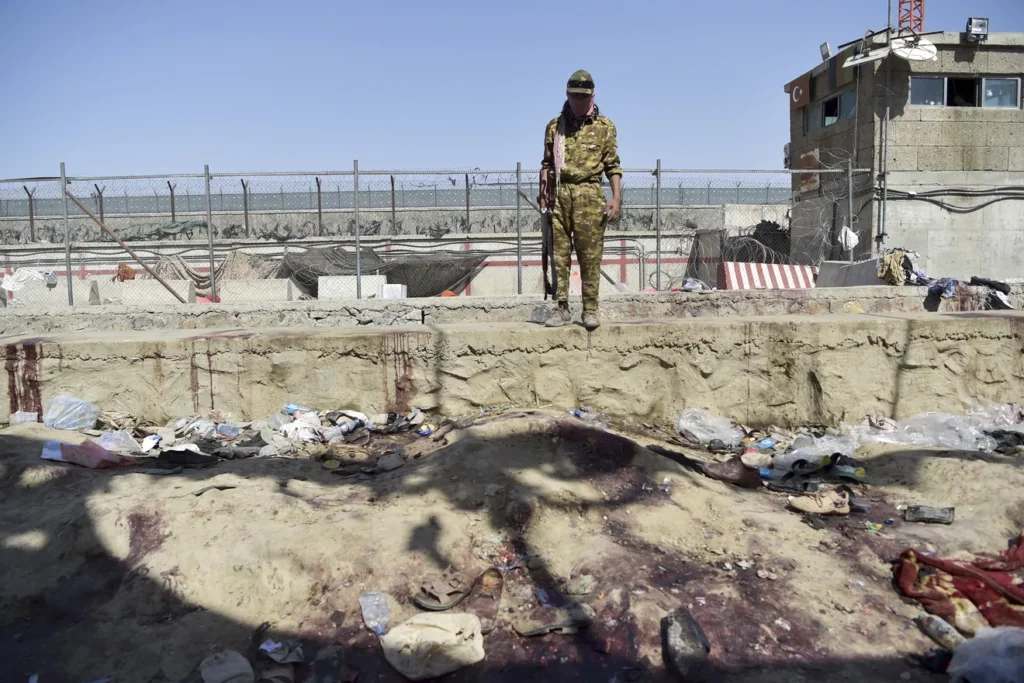
A Taliban fighter stands guard at the site of the August 26 twin suicide bombs near the airport in Kabul. Wakil Kohsar/RAFP via Getty Images
As president, Donald Trump ramped up the effort by moving strikes outside a cumbersome interagency vetting process and toward faster-moving “country teams” responsible for strikes in their areas, and President Joe Biden is partially continuing that approach. The prison at Guantanamo Bay is still open and holding 39 people, including 9/11 mastermind Khalid Sheikh Mohammed. All but two of them are being detained essentially without trial, and in the case of some, like Mohammed, after many excruciating rounds of torture.
These are policies that warrant evaluating in their own right. But they’re also worth considering as the remaining components of an outrageously wasteful policy disaster. It seems clear the war on terror was a bad idea. What are we going to do about it?
________________________________________________
Tags: 9/11, 9/11 truth, Abu Ghraib, Afghanistan, Anglo America, Anti-imperialism, CIA, Central Asia, Drones, False flag, Geopolitics, Guantanamo, Hegemony, Human Rights, Imperialism, International Relations, Iraq, Libya, NATO, Occupation, Pentagon, Rendition, Sanctions, State Terrorism, Taliban, Torture, UK, US Military, US empire, USA, Violence, War Economy, War on Terror, Warfare
DISCLAIMER: The statements, views and opinions expressed in pieces republished here are solely those of the authors and do not necessarily represent those of TMS. In accordance with title 17 U.S.C. section 107, this material is distributed without profit to those who have expressed a prior interest in receiving the included information for research and educational purposes. TMS has no affiliation whatsoever with the originator of this article nor is TMS endorsed or sponsored by the originator. “GO TO ORIGINAL” links are provided as a convenience to our readers and allow for verification of authenticity. However, as originating pages are often updated by their originating host sites, the versions posted may not match the versions our readers view when clicking the “GO TO ORIGINAL” links. This site contains copyrighted material the use of which has not always been specifically authorized by the copyright owner. We are making such material available in our efforts to advance understanding of environmental, political, human rights, economic, democracy, scientific, and social justice issues, etc. We believe this constitutes a ‘fair use’ of any such copyrighted material as provided for in section 107 of the US Copyright Law. In accordance with Title 17 U.S.C. Section 107, the material on this site is distributed without profit to those who have expressed a prior interest in receiving the included information for research and educational purposes. For more information go to: http://www.law.cornell.edu/uscode/17/107.shtml. If you wish to use copyrighted material from this site for purposes of your own that go beyond ‘fair use’, you must obtain permission from the copyright owner.
